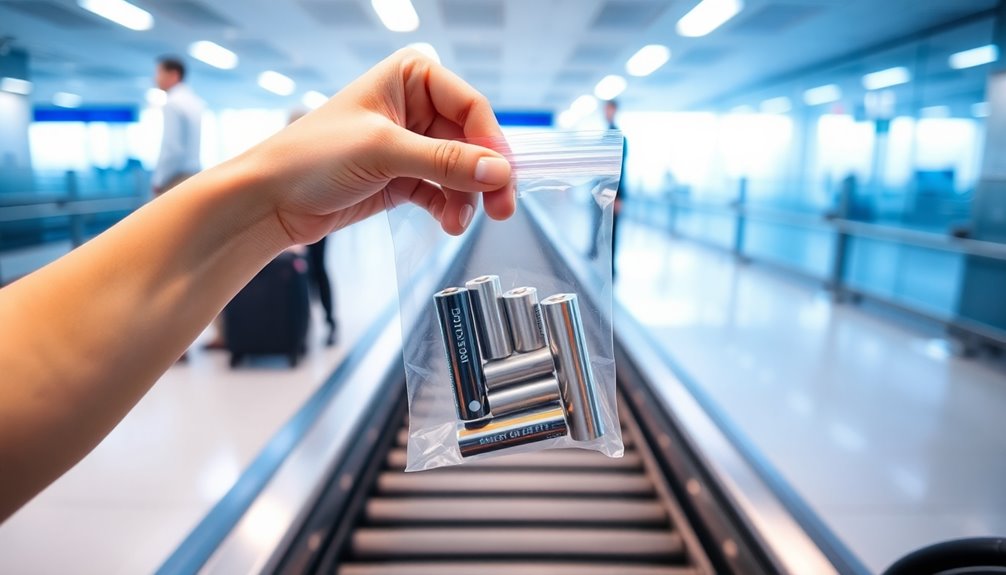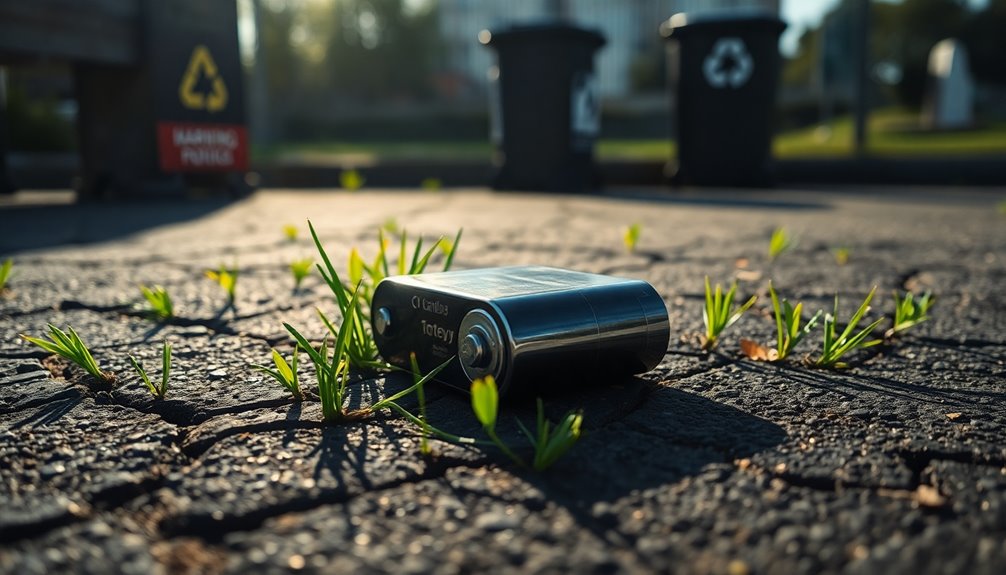Yes, batteries can explode if mishandled or improperly maintained. To protect yourself, charge batteries on non-combustible surfaces and keep them away from combustibles. Always inspect batteries for signs of damage like swelling, leaks, or corrosion, and store them in a temperature-controlled environment. Make sure you follow manufacturer guidelines closely to avoid overcharging. If you suspect a battery is damaged, discontinue use immediately and take safety precautions. Regular inspections and proper disposal play an essential role in minimizing risks. There's much more to discover about keeping your batteries safe and preventing hazards.
Key Takeaways
- Always inspect batteries for swelling, leaks, or corrosion before use to prevent potential explosions.
- Charge batteries on non-combustible surfaces, keeping them away from flammable materials.
- Store lithium-ion batteries in a temperature-controlled environment below 30% capacity to minimize risks.
- Maintain proper ventilation during charging to reduce heat buildup and explosion hazards.
- In case of battery damage, evacuate the area, alert others, and contact emergency services immediately.
Understanding Battery Explosions

Understanding battery explosions is crucial, especially since they can occur without warning.
Lithium-ion batteries are particularly susceptible to explosions due to thermal runaway, where a rapid temperature rise leads to a release of energy and potential rupture. Internal short circuits, often caused by manufacturing defects or damage, can create excessive heat and pressure, increasing the risk of an explosion.
Overcharging these batteries can also trigger thermal runaway, making it essential to monitor charging practices. Be aware of signs like swelling, unusual sounds, or visible leaks, as they indicate a failing battery.
Additionally, never use counterfeit or substandard batteries, since they greatly heighten the chances of malfunctions, including explosive failures.
Stay informed to keep yourself safe.
Common Causes of Battery Fires

Battery fires can happen unexpectedly, often due to a combination of factors that compromise safety. One major culprit is thermal runaway, where rapid temperature increases can lead to explosions from internal short circuits or overcharging.
Physical damage, like dents or punctures in lithium-ion batteries, can also expose them to risks, causing electrolyte leakage that heightens fire hazards. High ambient temperatures further increase internal pressure, making overheating and combustion more likely.
Additionally, using counterfeit or substandard batteries often means missing essential safety features, making them prone to failure. Ultimately, improper charging practices—such as relying on non-certified chargers or leaving batteries unattended while charging—can lead to overcharging and dangerous reactions.
Stay vigilant to prevent these risks!
Safe Charging Practices
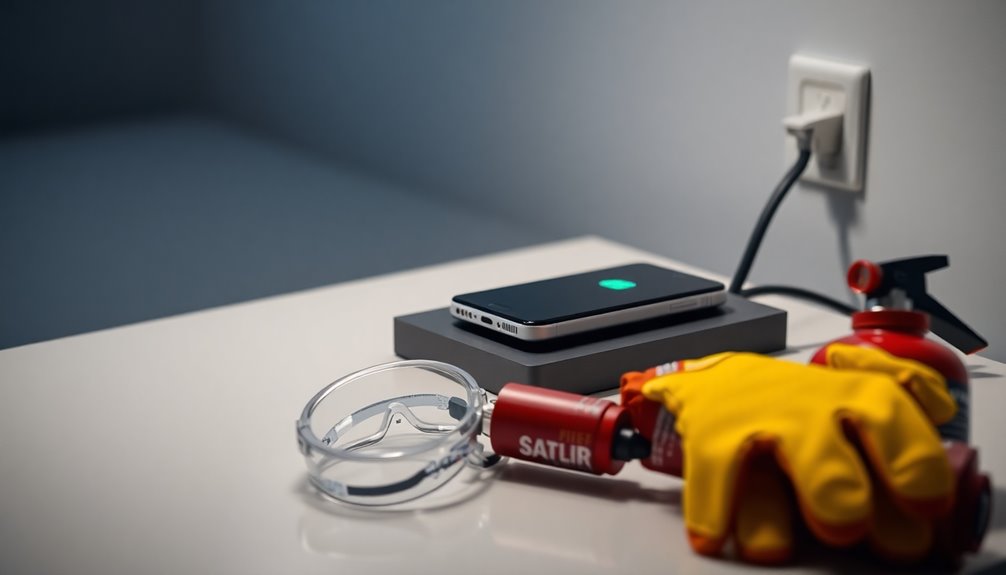
When charging your lithium-ion batteries, always do it on a firm, non-combustible surface to reduce fire risks.
Keep your batteries at a safe distance from flammable materials—three feet for large batteries and one foot for smaller ones.
Regularly check your charging area for safety and make sure it's well-ventilated to keep everything running smoothly.
Proper Surface Charging
To guarantee safe charging practices, it's crucial to charge your batteries on firm, non-combustible surfaces. This minimizes fire risks and guarantees stability during the charging process.
For larger batteries, maintain a separation of at least three feet from combustible materials, while smaller batteries should have at least a one-foot separation.
Regularly inspect your charging stations for safety compliance, checking for any signs of wear, damage, or other potential hazards. Ensure adequate ventilation in charging areas to prevent heat buildup and harmful gas accumulation, enhancing overall safety.
Finally, educate users on the importance of adhering to manufacturer specifications for charging practices to avoid overcharging and potential thermal runaway incidents.
Prioritize these steps to protect yourself and your batteries.
Maintain Safe Distances
Maintaining safe distances during charging is essential for preventing accidents and guaranteeing overall safety.
To minimize fire hazards, always charge batteries on firm, non-combustible surfaces. When charging large batteries, keep them at least three feet away from any combustible materials. For small format batteries, maintain a one-foot separation to reduce potential hazards. This simple practice can greatly decrease the risk of fire spreading in case of an incident.
Additionally, verify your charging area is well-ventilated to prevent heat buildup and harmful gas accumulation. Regularly check your charging stations for safety compliance, making sure they adhere to industry standards.
Regular Inspection Protocols
Regular inspections are a key part of safe charging practices. To guarantee your safety, charge batteries on firm, non-combustible surfaces, and keep them at least three feet away from combustibles for large batteries and one foot for smaller ones.
Conduct scheduled maintenance by routinely checking charging stations for frayed wires, damaged chargers, and proper ventilation. Educate everyone involved about following manufacturer guidelines on charging times and only using approved chargers to prevent overcharging.
Implement a systematic approach to monitor charge levels, which helps you identify potential issues early. By prioritizing these inspections and safety measures, you can greatly reduce the risk of battery-related incidents and keep your environment safe.
Proper Storage Techniques
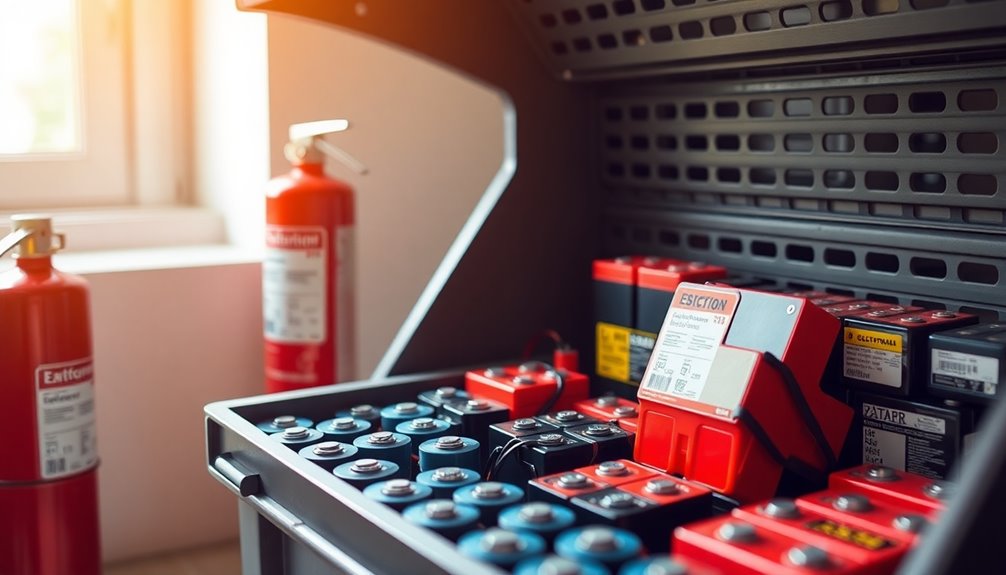
When storing lithium-ion batteries, it is crucial to keep them in a temperature-controlled environment, ideally between 40-80°F. This helps maintain their integrity and reduces the risks associated with thermal runaway. Always store batteries below 30% charge capacity for long-term storage to minimize the risk of overheating or explosion.
Position your battery storage bins at least 10 feet away from combustible materials, and use metal bins with lids for battery disposal. Regularly inspect these bins for wear and tear to further reduce fire risks. Monitor your storage area for signs of leakage or damage, ensuring a safe environment for your batteries.
| Storage Tip | Importance |
|---|---|
| Control Temperature | Prevent thermal runaway |
| Charge Level Below 30% | Reduce explosion risk |
| Distance from Combustibles | Minimize fire hazards |
| Use Metal Bins for Disposal | Lower fire risks |
Signs of Battery Damage

You need to stay alert for signs of battery damage to guarantee your safety.
Overheating, swelling, and any visible leaks or corrosion are critical indicators that something's wrong.
Addressing these issues promptly can prevent serious hazards down the line.
Overheating Indicators
Overheating is a vital warning sign that can indicate battery damage, so it is essential to stay vigilant. Here are some key overheating indicators to watch for:
| Overheating Indicators | Description | Action Needed |
|---|---|---|
| Increased Temperature | Battery feels hot to the touch | Inspect immediately |
| Swelling or Bulging | Casing appears deformed | Discontinue use |
| Erratic Charging Patterns | Unpredictable charge levels | Assess battery health |
| Unusual Sounds | Hissing or popping noises | Seek professional help |
| Visible Leaks or Corrosion | Signs of fluid or rust on terminals | Handle with caution |
If you notice any of these signs, take immediate action to prevent potential explosions or further damage.
Physical Deformation Signs
Physical deformation signs, such as swelling, bulging, or visible cracks, can indicate serious battery damage that increases the risk of failure or explosion.
If you notice any dents or irregular shapes on the battery, it's essential to take action. These physical deformation signs compromise the battery's structure and heighten the chances of thermal runaway, which can lead to fire risks.
Also, be alert for unusual sounds like hissing or popping, as they may signal imminent failure. If you feel overheating near the battery, that's a dangerous sign you shouldn't ignore.
Always inspect your batteries regularly and dispose of any that show these warning signs to keep yourself and your environment safe.
Leakage and Corrosion
When batteries begin to leak or show signs of corrosion, it's crucial to act quickly, as these issues can indicate significant internal damage.
Visible leakage or corrosion on battery terminals suggests electrolyte leakage, which poses a risk of malfunction and even explosion. If you notice swelling or bulging in the battery casing, it often means there's internal damage that could lead to hazardous conditions like thermal runaway.
Regularly inspect your batteries for signs of corrosion; corroded terminals can create poor connections and increase the risk of overheating.
Handle any batteries displaying leakage or corrosion with caution, and dispose of them in designated containers.
Store your batteries in cool, dry environments to help mitigate corrosion and prolong their life.
Emergency Response Steps
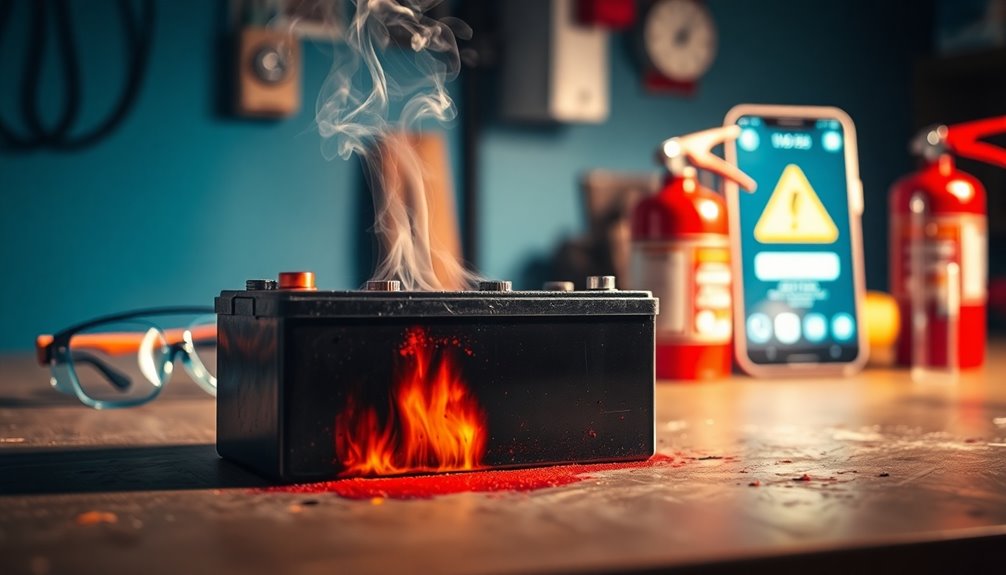
If a battery explosion occurs, your immediate priority should be to evacuate the area to protect yourself and others from harmful fumes and flames.
Alert nearby individuals to leave the vicinity as quickly as possible, ensuring their safety from potential hazards.
Contact emergency services promptly to report the explosion and request assistance.
If moving the battery is necessary, wear protective gear to avoid direct contact and minimize injury risk.
Open windows and doors to ventilate the area, dispersing any toxic gases that may have been released.
However, don't attempt to extinguish the fire with water, as it can worsen the situation.
Following these emergency response steps can help keep you and others safe during a critical incident.
Fire Safety Measures

To guarantee safety around batteries, implementing effective fire safety measures is essential.
Here are some key Safety Precautions you should follow:
- Store lithium-ion batteries between 40-80°F to prevent risks.
- Charge batteries on non-combustible surfaces, keeping them at least three feet away from combustibles.
- Use metal bins for battery disposal, positioned at least 10 feet from other storage.
Long-Term Battery Maintenance
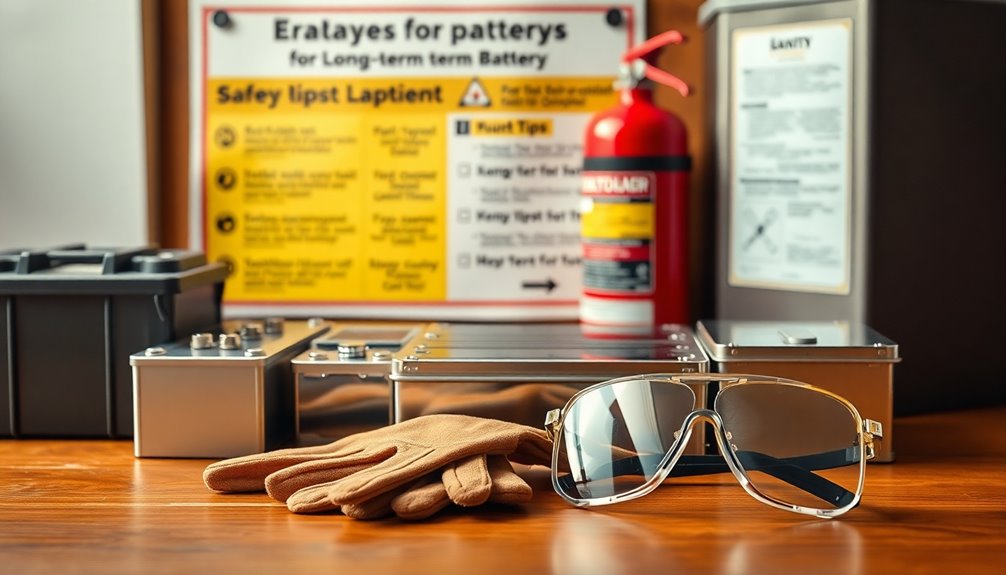
Maintaining batteries for the long haul is essential for both safety and performance. For longer periods, store lithium-ion batteries below 30% charge to lower the risk of thermal runaway. Regularly inspect your batteries for damage, like swelling or leaks, and dispose of any damaged units right away. A maintenance schedule helps track performance and extends lifespan. It's also important to consult battery experts for guidance on safe reconditioning practices.
| Maintenance Tip | Recommendation |
|---|---|
| Charge Level | Below 30% for long-term storage |
| Inspection Frequency | Monthly checks for damage |
| Storage Environment | 40-80°F temperature-controlled space |
Educate yourself and your staff on using only certified batteries and adhering to manufacturer guidelines to guarantee safety and peak performance.
Frequently Asked Questions
What Are the Dangers of Battery Safety?
When it comes to battery safety, you need to be aware of several dangers. Overcharging can lead to overheating, increasing the risk of thermal runaway.
If you notice any swelling, leaks, or cracks, don't ignore them—those damaged batteries are hazardous.
Using poor-quality or counterfeit batteries can also be risky, as they might lack essential safety features.
Ultimately, avoid exposing batteries to extreme temperatures, as this can compromise their integrity and lead to dangerous situations.
What Is the Most Common Cause of Battery Explosions?
Imagine a quiet volcano, just waiting to erupt; that's what a battery can become under the wrong conditions.
The most common cause of battery explosions is thermal runaway, where rising temperatures spiral out of control, releasing a fiery energy burst.
Internal short circuits, often from defects or damage, can also ignite trouble.
Overcharging adds fuel to the fire, while counterfeit batteries turn up the heat, making them ticking time bombs.
Stay vigilant!
How Do You Prevent Battery Explosions?
To prevent battery explosions, store your lithium-ion batteries in a cool, dry place, ideally between 40-80°F.
Keep them charged below 30% capacity and use only manufacturer-approved chargers.
Monitor charging times to avoid overcharging, and regularly check for any signs of damage like swelling or leaks.
Charge batteries on non-combustible surfaces and maintain proper ventilation.
When disposing of damaged batteries, make certain terminals are covered to prevent accidental short circuits.
How Can You Protect Yourself From Batteries?
Batteries can be as unpredictable as a cat on a hot tin roof! To protect yourself, store them in a cool, dry place between 40-80°F.
Always use manufacturer-approved chargers and pay attention to charging times.
Regularly check for damage like bulging or leaks and dispose of any faulty batteries safely.
Keep a safe distance from combustibles while charging, and make sure you know how to recycle them properly to avoid accidents.
Conclusion
In a world where technology powers our lives, the potential for battery explosions can feel alarming. But by practicing safe charging and storage techniques, you can enjoy your devices without worry. Keep an eye out for signs of damage, and remember that a little caution goes a long way. With proper maintenance, you'll balance the thrill of innovation with the peace of mind that comes from being prepared. Stay safe, and let your gadgets enhance your life!




